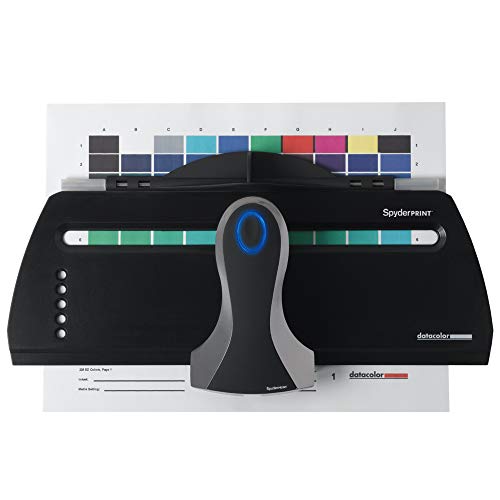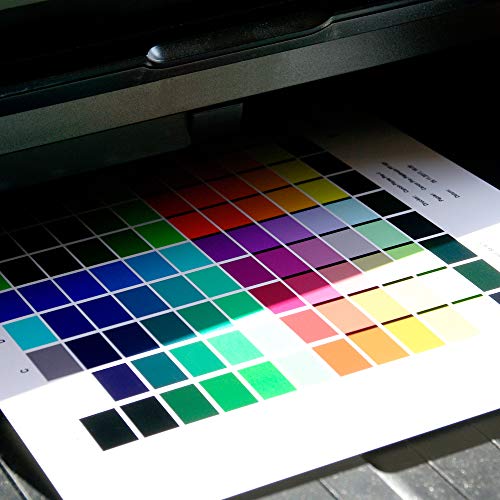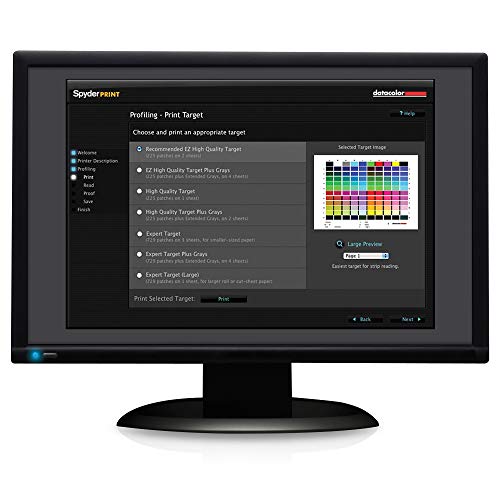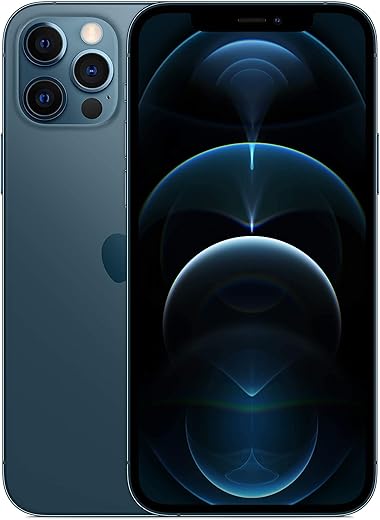- 𝗣𝗥𝗢𝗙𝗜𝗟𝗜𝗡𝗚 𝗦𝗣𝗘𝗘𝗗 & 𝗔𝗖𝗖𝗨𝗥𝗔𝗖𝗬: The strip reading Spectrocolorimeter creates custom profiles in minutes with easy-to-read targets for color and black and white. Includes the improved SpyderGuide for convenience in creating profiles easily and accurately
- 𝗜𝗡𝗧𝗨𝗜𝗧𝗜𝗩𝗘 𝗣𝗥𝗢𝗙𝗜𝗟𝗘 𝗖𝗥𝗘𝗔𝗧𝗢𝗥: Usability is so improved in this step-by-step process you don’t need an extra manual – it’s quite intuitive!
- 𝗘𝗡𝗛𝗔𝗡𝗖𝗘 𝗣𝗥𝗜𝗡𝗧 𝗣𝗥𝗘𝗖𝗜𝗦𝗜𝗢𝗡: Unique SpyderProof function gives you a series of carefully selected images to evaluate detail from a photographer’s point of view. Profile Softproof available for each unique printer profile.
- 𝗖𝗢𝗠𝗣𝗟𝗘𝗧𝗘 𝗘𝗗𝗜𝗧𝗜𝗡𝗚 𝗖𝗢𝗡𝗧𝗥𝗢𝗟: Take total control of your print output and achieve gallery-quality prints with Datacolor Spyder Print, the leading calibration and profiling tool for photographers and designers.
- 𝗘𝗟𝗘𝗩𝗔𝗧𝗘 𝗬𝗢𝗨𝗥 𝗪𝗢𝗥𝗞𝗙𝗟𝗢𝗪: Datacolor and Adobe work hand-in-hand to offer the complete package for your photography workflow. Get a complimentary Adobe Creative Cloud Photography plan – 90 day trial with your Spyder purchase. A redemption code will be sent upon Spyder activation.





Datacolor Spyder Print – Advanced Data Analysis and Calibration Tool for Optimal Print Results, Perfect for Photographers, Graphic Designers, and Printing Professionals
$344.00
Last updated on 00:32 Details
| Included Components | S4SR100 |
|---|---|
| Print media | Paper (plain) |
| Scanner Type | Photo |
| Max Input Sheet Capacity | 100 |
| Compatible Devices | PC |
| Warranty Type | Limited Warranty |
| Duplex | Manual |
| Hardware Interface | USB |
| Control Method | App |
| Specific Uses For Product | color management, print output control for professionals in the photography and design industries |
| UPC | 763615973304 151903602867 163120457007 875720001244 |
| Global Trade Identification Number | 00875720001244 |
| Product Dimensions | 14.1 x 7.3 x 3.1 inches |
| Item Weight | 1.65 pounds |
| Item model number | S4SR100 |
| Is Discontinued By Manufacturer | No |
| Date First Available | January 4, 2012 |
| Manufacturer | Datacolor |
| Language | German |
| Country of Origin | China |











Afterhourshop –
I had high expectations of this device given the price, and because I also own the Spyder5 PRO from Datacolor, which despite having a glitchy room-light switching feature, has always worked perfectly for calibrating my screens. So, you could say I trusted the Datacolor brand. Unfortunately, this SpyderPRINT product is garbage.
Issues I experienced:
1) The software was buggy on my Mac. Until I changed permissions on my ~/Library/ColorSync/Profiles folder, it would let me get all the way through the patch reading process, and then refuse to save the profile. However, the error message given was that the name I was trying to use to save was not allowed. It took me 30 minutes of research online to figure out that the problem was nothing to do with the naming of the profile.
2) The hardware itself doesn’t work very well. The unit doesn’t seem to self-calibrate reliably, and will frequently set the wrong white point from the white patch in the cradle, which messes up the entire process. Additionally, the scanner doesn’t fit very well in the plastic guide rail, and it’s very easy for it to dislodge from the rail while scanning patches. Finally, the cable is so stiff that keeping the unit flat and level requires constant vigilance while scanning – if you loosen your grip the unit will want to pull away from the paper surface.
3) The two issues above could be forgiven if it wasn’t for this one: my unit generated totally inaccurate profiles from the targets I printed out. I profiled two different Hahnemuhle Fine Art papers on my Canon PIXMA Pro-10. These papers were fresh out of the box, the inks were factory OEM, the room lights were 5000K high CRI – heck, I even handled the paper with cotton gloves and allowed a 30-minute drying time! Furthermore, I correctly disabled Color Matching while printing the patches, and set the correct media type (“Other Fine Art Paper 1”). The targets seemed to print fine, but when I went to scan them the patches did not seem to match the expected colors very well. It wasn’t until I went to print with the profile that I saw a marked reddish color shift that looked significantly different from the soft-proof. The printing was done from Photoshop, using the same media type, of an image edited on my calibrated EIZO display, with the correct profile selected and making sure Photoshop was managing colors instead of the printer. This clear mismatch suggests that the profile I created was quite inaccurate. To confirm my suspicion, I downloaded a Hahnemuhle-supplied generic ICC profile for my printer and paper type (which isn’t custom to my specific printer unit) and the colors came out *WAY* closer to my screen than what printed using the SpyderPRINT profile. Upon pulling up the SpyderPRINT profile in ColorSync and comparing it to the manufacturer profile, they are really different – the difference is much greater than you would expect for a custom vs. generic printer/paper profile (see attached screenshot).
A final annoyance with using this unit – in addition to the crap profiles it creates – is that it wants to print 8.5″x11″ size targets, but it doesn’t take into account that most Canon printers insist on a 30mm border for fine art papers. This meant I had to scale the printed target, dismiss the complaints from the software, and scan patches individually (which is supposed to be more accurate, but didn’t seem to be, and took 3x as long).
Bottom line: the SpyderPRINT is a waste of money, and doesn’t work well at all.
JonG –
I use 3rd party ink from Precision Colors. After awhile I think the syringe got slightly contaminated when refilling so there was a slight color shift from the OEM ink profiles. Corrects it after profiling.
only flaw was the measuring head had a slight dent when it arrived. QC might be a problem
Afterhourshop –
Ok, so I have the $2K i1 Pro2 and I got this as I wanted to compare them.
I am NOT going into deep details, but I can say that this hands down does a great job of making your prints MUCH better with fine tuning the colors and tones. I used the Expert patchs of about 750 and with Gray tones, and I used the Click method of EACH patch of color. This took some time and patients, BUT, it is the right way to go. The other method is LAME, and dont EVEN think about printing on a large sheet with more patches. WASTE of time. Print on a 8.5×11 or something so that cheap plastic paper guide that is included can actually help. This is where the i1 X-Rite is far superior, but SURELY not worth the $ extra for personal use.
So do the readings patch at a time, and you will be sure you got a good reading. My BW prints using color inks is not nutral and with excellent tone. Also colors are much better, rich and good separation.
Very much worth $350 if you want to make higher quality prints. Would the X-Rite do better, not significant enough. The only time the X-rite makes sense is if you do this as a business with AMNY papers and are often making custom profiles. But if you have 3-5 fav papers, you certainly do not need to spend $2k… SHAME on X-Rite for the rip off I purchased. Sellers hype:” Oh, no this is the only great one that will do the job, others come close, but not as good”. REALLY? you take a look at the prints? AND, this allows for tweaking and making adjustments, so if there is some image with hard tomes the printer is challenged on, you can make the call to tweak further manually.
I am a photographer, print professional. I use LUT calibrated monitors using the Xrite as well. but my volume in print is low. For most folks who like to print seriously and are pros, you dont need Xrite. This is likely more accurate than Colormunki, and is suitable for such personal or client prints.
JonG –
The final step to great looking pictures. You bought the camera, took the pictures and printed them. But wait they look nothing like what you saw in the camera or on your monitor. Now what? the problem is all the equipment it needs to be calibrated to the same standards, from the camera to the monitor, and yes the printer too. The biggest problem is if you change papers or ink brands (even with the other two items calibrated), the color changes…and your back to square one it seems. Enter Spyder print this device creates printer profiles for each type of paper and ink you use. this gives you back control over the color of your prints. This does use up some ink and paper to make the profiles, but much less than using trial and error to make the print look right.